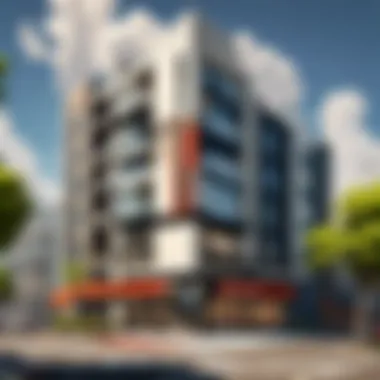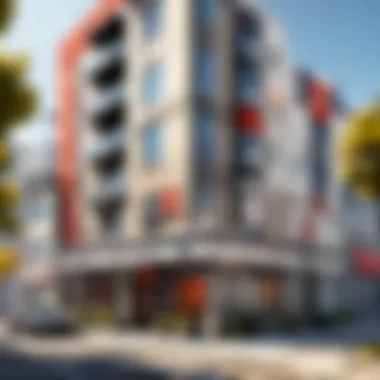Apex Apartments: Redefining Urban Living in the U District


Intro
Urban living forms a crucial aspect of modern society, particularly in vibrant areas like the University District. Understanding locations such as the Apex Apartments helps one to grasp the dynamics at play in urban developments. This part of the article aims to explore those dimensions, which include architectural features, amenities provided, demographic insights, and other factors critical for anyone considering urban life.
In recent years, urbanization has accelerated. The need for comfortable and appealing living spaces has made apartments a key element of city life. Here, the Apex Apartments stand out not just for the physical structure but also for how they contribute to the surrounding community. By analyzing these apartments, one can unveil insights relevant for potential residents, investors, and urban planners alike.
The analysis will cover these major elements:
- Architectural Design: How the design integrates with urban aesthetics and functionality.
- Location Advantages: Accessibility, proximity to amenities, and its impact on lifestyle.
- Amenities Offered: The importance of community facilities in enhancing living standards.
- Market Positioning: Insights on pricing, target demographic, and value propositions.
- Impact on Urban Living Dynamics: Examining the broader influence on community development and sustainability.
The aim here is to provide a thorough understanding, making the case for why locations like Apex Apartments are worthy of consideration in the discussion of urban life amidst evolving city landscapes.
Prologue to Apex Apartments
Apex Apartments represents a specific niche in urban living within the University District. They embody a unique combination of modern urban architecture and functional amenities. Understanding Apex Apartments can help potential residents, investors, and urban developers alike in grasping the nature of urban living dynamics, specifically in a university-centric area.
These apartments appeal particularly to those looking for convenience and community. The U District is home to a diverse demographic, predominantly composed of students and young professionals. Apex Apartments provides essential facilities that cater to their lifestyle and needs.
When examining such living arrangements, numerous factors come into play. Key considerations include location, design, and affordability. Examining these apartments critically also provides insights into the ongoing evolution of urban landscapes.
Realizing the broader impact of these developments assists stakeholders, including city planners, to make informed decisions. Apex Apartments can illuminate trends in housing preferences, economic development, and community engagement within urban settings.
Enhancing urban living experiences sometimes demands new constructions that learn from previous developments, making observance of cases like Apex Apartments critical for holistic urban planning.
As cities continue evolving, understanding structures like Apex Apartments offers valuable context. The relevance specified here contributes to both personal insights for potential residents and strategic implications for urban advancement. Thus, the introduction to Apex Apartments is more than just a locality discussion. It reflects ongoing changes in modern housing that influences various sectors and individuals."
Location and Significance of the U District
The University District, often referred to as the U District, represents a vital area in Seattle. It serves as a bridge between academic life and urban dynamics, blending student living with commercial vibrance. Data shows this neighborhood thrives on the push-pull of its mixed demographic. With distinct features such as historical landmarks and hubs for transport, residents are ensured convenience and enriched experiences derived from their surroundings. Understanding these points highlights the location’s immensity in context to the Apex Apartments.
Historical Context
The U District has a captivating history, stemming back to its establishment as a neighborhood adjacent to the University of Washington. Originally, it evolved from a patch of isolated farmland into a focal point of educational pursuits and local commerce. The ongoing development has been quite significant; new establishments continue to reshape its landscape, aiming to match modern needs while preserving its rich heritage. Studying historical events in this area is essential because it offers insight into how past decisions guide current zoning and community policies, which software translates to higher living satisfaction and accessibility.
Proximity to Key Landmarks
The U District is replete with prominent landmarks that resonate with both residents and visitors. The proximity to the University of Washington is perhaps the most significant advantage. Nestled nearby are various cultural institutions such as the Burke Museum and the Henry Art Gallery. These loci provide not just educational opportunities, but help nurture an enriching lifestyle for residents. Everyday amenities, including grocery stores, cafes, and recreational parks, can be found in abundance. This arrangement not only caters to the daily needs of residents but reinforces community bonds.
Transport Accessibility
Transport in the U District is another essential element further enhancing its appeal. Residents tend to favor modes of transit such as buses and light rail. Services offered by Seattle's comprehensive transit system facilitate easy travel to downtown, neighboring districts, and even Seattle-Tacoma International Airport. The recently developed light rail station is strategically placed to ease access even more. Efficient transit options are crucial for residents, as they foster a balance between urban living and connectivity, subsequently elevating life quality in the area.
"Great living spaces must integrate convenience and culture, which is precisely what the U District achieves."
Architectural Features of Apex Apartments
Understanding the architectural features of Apex Apartments provides insight into how the design and layout impact urban living. A well-structured residential space can enhance quality of life for residents. Several specific elements are critically important.
Design Philosophy
Apex Apartments embrace a contemporary design philosophy. The layout focuses on open spaces that facilitate light infiltration. Residents enjoy a strong connection to the outdoor environment while staying protected from the urban hustle.
Low-key yet sophisticated materials are used target both beauty and functionality. Choosing high-quality finishes helps in reducing long-term maintenance. Thus, a thoughtful approach to aesthetics complements practicality in design.
Structural Highlights
The structural highlights of Apex Apartments take both stability and openness into account. The building incorporates advanced engineering techniques that optimize space.
- Large windows not only increase natural light but also enhance the views available to residents.
- The strategic placement of common areas encourages community interactions amongst residents, fostering a sense of belonging.
Additionally, the choice of environmentally friendly materials aids in durability and sustainability. This highlights the forward-thinking nature of the development, especially in a bustling urban context.
Sustainability Considerations
Sustainability is central to the planning of Apex Apartments. From the outset, efforts to minimize environmental impacts are prioritized. Specific designs include energy-efficient appliances, enhanced insulation, and water conservation features.


- Energy-efficient systems reduce overall consumption and promote eco-friendliness.
- Using recycled materials vastly diminishes the environmental footprint of the construction.
Building features extend beyond material considerations. Landscaped green roofs provide natural insulation and contribute to biodiversity by attracting local flora and fauna. Narviing these elements shows commitment to promoting a healthy living environment.
Ultimately, architecture deeply influences urban living experiences. Apex Apartments not only aesthetic inspirations but are also benchmarks of sustainability, comfort, and community efficacy.
Amenities and Services Available
Amenites and services available at Apex Apartments significantly shape the urban living experience. The inclusion of premium facilities and services helps build an engaged tenant community, making the apartments more attractive to potential residents. With bustling lifestyles in urban areas, these features are essential to address daily needs and enhance quality of life.
Recreational Facilities
Recreational facilities play a vital role in fostering a sense of community among residents. The sports area offers options like basketball and volleyball courts, where residents can engage in friendly competition or leisure activities.
Moreover, fitness centers in the premises equip residents with necessary resources to fulfill their exercise schedule without traveling far. Physical well-being is essential and readily available workout space enables convenient routines. Availability of resident lounges and game rooms provide social hubs where individuals can relax and share interests.
- Key Features:
- Sports courts: Basketball, volleyball.
- Fitness center: Cardio and weight training equipment.
- Community lounges: Designed for gathering and leisure activities.
Laundry and Maintenance Services
The practical aspect of housing includes reliable laundry and maintenance services. Apex Apartments integrate on-site laundry facilities that save residents from time-wasting travel to laundromats. Machines are always well maintained, ensuring extended uptime for use.
In terms of maintenance, efficient response times often assures tenants that concerns like plumbing or electrical issues will receive prompt attention. Resident satisfaction tends to increase when such basic needs are cared for effectively, leaving more time for leisure activities.
- Benefits:
- On-site laundry facilities: Convenience of operation within the building.
- Responsive maintenance: Faster solutions to immediate problems.
Community Spaces
Community spaces are integral for residents to connect and exchange ideas. Dedicated areas like rooftop gardens or outdoor patios enable residents to enjoy the local environment while mingling with neighbors. Such spaces can host organized events or serve as informal meeting points.
Additionally, dedicated study areas cater to students, allowing them to focus away from distractions within their units. This variety in space expands opportunities for collaboration and socialization among diverse resident demographics.
- Types of Community Spaces:
- Rooftop gardens: Relaxation and social activities.
- Study areas: Quiet zones for focused work.
- Patios: Areas for casual gatherings.
The quality of life in urban settings is profoundl impacted by the amenities and services available, establishing a track record of resident satisfaction.
Target Demographic and Resident Profiles
Understanding the target demographic and resident profiles is crucial when analyzing any apartment living situation. In the case of Apex Apartments, the U District provides a rich blend of residents with diverse backgrounds. This diversity shapes the community experience. Through examining distinct groups — students, young professionals, families, and long-term residents — it is possible to identify some unique characteristics and needs that contribute to the overall appeal of the property.
Student Population
The U District is home to several universities, making the student population a significant demographic for Apex Apartments. Many students prioritize modern amenities, affordability, and proximity to classes. The living experience in these apartments often has impacts such as:
- Convenient Location: Proximity to the University of Washington and other institutions helps reduce commute times for students.
- Community Engagement: Apartment complexes like Apex often feature social events aimed at fostering community among residents.
- Accommodating Shared Living: Students frequently seek options that allow for shared living, which can be extremely ideal in these apartments due to multiple bedroom configurations.
Young Professionals
Young professionals who favor urban living also flock to the U District. This demographic typically values certain aspects of their living space:
- Work-Life Balance: Young professionals appreciate being close to their workplaces or anywhere with good job prospects. They often favor housing that helps facilitate efficient commute.
- Social Opportunities: Such residents often look for nearby nightlife and restaurants. Apex Apartments, located in a vibrant area, presents ample chances for social interactions.
- Amenities: Fast internet and modern facilities often attract young professionals making their workspace very important.
Families and Long-term Residents
Lastly, families and long-term residents may seek stability in lifestyle that builds a sense of community over time. Their requirements often differ from those of single residents.
- Stability: Families often look for longer leases, security features, and reliable maintenance services.
- Community Facilities: On-site amenities such as playgrounds, gyms, and community rooms appeal to families with children.
- Network Building: Long-term residents benefit from forming a supportive community. They often value neighbors who develop friendships over years on the same street.
Respecting the needs of a diverse resident base is fundamental. With a varied and responsive approach to landlords and management can build an enriching urban living experience. Each profile contributes uniquely to the culture at Apex Apartments, empowering them to meet each group's expectations. Understanding these demographics can improve living environments for all residents while also optimizing community experiences.


Market Analysis of Apex Apartments
The seismic shifts in urban living necessitate a thorough examination of the housing landscape. A market analysis of Apex Apartments offers valuable insights into not just the properties themselves but also broader trends within the U District. Such analysis helps investors, residents, and city planners to understand the dynamics at play and make informed decisions. The focus will be on rental trends, pricing comparisons, and investment potential.
Rental Trends
Exploring rental trends reveals essential patterns that give insight into tenant behavior in the U District. The data shows fluctuations in prices over time influenced by various factors such as location desirability, amenities available, and changes in population density. For instance, the growing number of students and young professionals moving into the area impacts the demand significantly.
Historical data indicates an increasing trend over the past few years, with rental prices steadily rising, sometimes outpacing local wage increases. Predominantly, this is due to the attributing factor of the continual development of urban amenities and services, which transform the neighborhood. Enough rental units are not released onto the market, leading to tighter inventory and higher demand. Some of the key considerations are:
- Changes in college enrollment affecting student housing demand.
- Economic conditions influencing local job growth and in return, migration to the area.
- Nearby developments that either uplift or detract from tenant desirability.
Comparative Pricing
When discussing comparative pricing, it is crucial to analyze Apex Apartments alongside similar properties within the neighborhood. Such analysis allows potential tenants to gauge the competitive nature of rental costs. Apex Apartments are generally positioned near the mid to higher end of the pricing spectrum. This price point reflects a blend of modern amenities, prime location conveniences, and a reputation for quality.
Key points in the comparison include:
- Location specifics: Proximity to the university, public transport, and recreational facilities often dictate a premium.
- Amenities variation: Level of service offered, such as security and maintenance, has a weight on rental prices.
- Size and layout differences: Square footage and unit configurations will also play a role in determined prices.
Businesses and residents looking into values must understand the local market and emerging pricing trends to determine if they are seeiing fair marlet apps in the U District.
Investment Potential
As an insightful aspect of the market analysis, investment potential in Apex Apartments needs considerations. Currently, the U District shows signs of growth which appeals to both small-time landlords and large-scale property investors. Investments are aligned to consistent returns reflecting the higher demand for housing, especially culturally inviting areas.
Take note of factors restiltintow the U District:
- Urban development plans carried out by the city which will likely add value to Properties.
- Infrastructure improvements such as transportation links that enhance accessibility.
- Vibrant community culture and its ongoing magnetic effect to residents, leading to long-term leases.
To sum up, a sound market analysis of Apex Apartments indicates favorable conditions for investment and living. The trajectory is promising, highlighting not just growth dynamics but also attracting urban engagement among various demographics.
Community Impact of Apex Apartments
Economic Contributions
The establishment of Apex Apartments signifies potential economic contributions within the U District. Firstly, the apartments increase the local employment opportunities. With management, security, and maintenance necessities, the Apex provides jobs to residents. This boosts not just individual income but also stimulates consumption within nearby businesses.
Additionally, property taxes from the development can bolster municipal budgets. Higher property density often leads to increased total tax revenue, which makes possible better public services that benefit all residents of the U District. Therefore, a vibrant market begins to cultivate as newcomers, attracted by these apartments, bring diverse spending power and interests.
In summary, Apex Apartments aid in the economic rejuvenation of their surroundings, marking them important players in the local economy.
Social Dynamics
The integration of Apex Apartments also impacts social dynamics in the U District significantly. The design emphasizes community through shared spaces. This encourages social interactions among residents, fostering friendships and a sense of belonging. Diverse demographics residing here—students, young professionals, and families—create a unique blend of perspectives.
Such a populace encourages networking, collaboration, and cultural exchanges. Events organized in community spaces become necessary staples, promoting inclusivity. Thus, Apex Apartments not only serve as a place to live but also become vibrant hubs for social engagement, balancing diverse needs.
Moreover, the influx of residents into this area potentially lowers the isolation often seen in urban living. A strong community vibe is increasingly essential for modern urban environments, making areas like U District viable for longer residencies.
Urban Development Trends
Looking ahead, the presence of Apex Apartments influences urban development trends within the U District. As demand increases for convenient living spaces in a prime location, more similar developments may emerge. This trend reflects broader shifts in urban planning, which place value on mixed-use spaces.
Continued growth could spur the development of better infrastructure—public transportation improvements and expanded commercial spaces may follow. With newfound residents, local governments often act to accommodate this growth, as seen in many successful urban areas.
In essence, Apex Apartments set a benchmark, enhancing regional plans aimed at redefining urban living. Progressive transitions in development demonstrate a growing commitment to sustainable and engaging communities in cities open to innovation.
Challenges and Considerations
Examining the Challenges and Considerations related to the Apex Apartments is crucial for understanding their role in the broader context of urban living. This section will highlight significant factors that affect both the residents and the community at large. Key insights will assist potential tenants, investors, and urban planners in comprehending the intricacies of living in such developments.
Housing Affordability Issues
Housing affordability remains a pressing concern in most urban centers, including the University District. As demand for apartments increases, so do rental prices. Apex Apartments even face scrutiny regarding their pricing, which some say does not align with the average income of local residents. This situation presents challenges for lower and middle-income households looking for suitable housing.


Many argue that comprehensive strategies need to emerge to address these housing affordability issues.
- Possible Solutions:
- Introduce affordable housing initiatives.
- Explore subsidies for lower-income renters.
- Encourage mixed-income developments.
Lack of affordable housing can lead to increased commuting times, social fragmentation, and even displacement of residents, suggesting that addressing affordability goes beyond just numbers.
Environmental Concerns
As urban spaces grow denser, environmental concerns escalate. The building and maintenance of Apex Apartments could potentially impact local ecosystems. Housing projects can contribute to reduced green spaces, leading to adverse effects on air quality and biodiversity. Residents and environmental experts must consider whether such developments are sustainable in the long run.
Efforts are being made to build in environmentally friendly ways, including:
- Using sustainable construction materials.
- Incorporating energy-efficient technology.
- Establishing greenery around the buildings.
Environmental sustainability should not just be an afterthought but integral to any new development model. Neglecting this information may reshape community perspectives, creating long-term resentment or resistance to future constructions.
Community Response
The advent of Apex Apartments sparked varied responses in the community. Increased foot traffic and new residents can invigorate the local economy, but changes may also breed discomfort among long-term residents. Some worry that rising rents and population density could threaten the character of the neighborhood.
Community forums and feedback mechanisms can help bridge the gap between developers and residents. Considerations include:
- Ensuring that local residents have a say in future projects.
- Running informational sessions to promote transparency about upcoming changes.
- Fostering community engagement initiatives to strengthen connections.
Many residents advocate for measures that protect existing cultural elements within the U District. Balancing this growth with community preservation remains a constant dialogue.
Understanding the challenges and considerations related to the Apex Apartments influences not just individual choices but also shapes communal identity and future urban development in the U District.
Future Developments in the U District
The dynamics of urban living in the U District are influenced heavily by future developments. These impending changes shape the neighborhood’s potential for growth, lifestyle improvements, and sustainability initiatives. With a focus on the renovations and new constructions, understanding these developments is crucial for residents and investors alike.
Urban Planning Initiatives
The role of urban planning in the U District cannot be understated. City planners are actively engaging in initiatives designed to enhance functionality and aesthetics of urban spaces. Planned projects could include:
- Low-Income Housing: Tackling the rising numbers of those in need of affordable housing. This development would ensure that the U District sends a message of inclusivity.
- Enhanced Public Transport: Future enhancements could reduce commute times and improve access. Investments in new transit systems are vital for seamless connectivity.
- Green Spaces Creation: Initiatives to develop parks and recreational areas will enhance quality of life. These spaces provide residents with peace amid urban hustle.
Urban planning focuses on a vision that extends real estate’s impact. It also considers the interaction between facilities and the community, fostering a sense of belonging.
Expected Trends for Residential Living
As the U District evolves, several trends in residential living are becoming apparent. The integration of technology, sustainability practices, and community needs is essential. Some expected trends include:
- Smart Living Solutions: Innovations like smart apartment systems could offer enhanced convenience and energy efficiency. These technologies may cater to the tech-savvy younger crowd.
- Co-Living Spaces: This model, which promotes shared living arrangements, is gaining traction. Co-living not only minimizes rent but also nurtures community.
- Sustainability Practices: Skepticism about climate change is shaping residential choices. Apartments that prioritize sustainable practices may be more attractive to buyers and renters.
Continuing trends in urban housing will reflect larger societal shifts. It emphasizes a move away from traditional forms of living, pushing toward innovation and responsiveness in real estate offerings.
The successful integration of these developments would not only reshape living patterns but also boost the overall appeal of the U District as a vital urban area.
Ending
In considering the Apex Apartments within the context of urban living in the University District, it is essential to capture the synthesis of the observations made in earlier sections. The attention to architectural innovation, coupled with strategic location and diverse amenities, emerges as a quintessential element redefining modern urban dimension. Furthermore, the complex serves as a case study regarding community interactions and societal spheres.
Summary of Key Findings
A review of critical aspects illustrates the value of the Apex Apartments:
- Architectural Features: Notable for their contemporary design that prioritizes functionality and aesthetics.
- Amenities: Offers a range of recreational and community spaces, enhancing social interaction among residents.
- Market Demand: Attracts a varied demographic from students to young families showcasing substantial rental interest.
- Community Impact: Promotes economic growth through local partnerships and enhances the cultural fabric of the U District.
These points highlight how Apex Apartments contribute significantly to urban dynamics, shaping residential preferences and influencing neighborhood character.
Implications for Future Research
The examination of Apex Apartments opens avenues for further research in urban living. Future studies can explore:
- Longitudinal Impact: Analyzing how sustained residency affects urban community cohesion over time.
- Sustainability: Deeper inquiry into practices for minimizing environmental footprint, both internally within apartments and externally in urban settings.
- Demographic Shifts: Monitoring emerging trends in who chooses to live in such developments and how this affects community design.
These considerations present critical knowledge gaps which are pertinent in the evolving discussions on urbanization, making them worthwhile for policymakers and urban planners.
The Apex Apartments are not just living spaces but represent a fertile ground for future urban studies, resonating with both residents and scholars alike.



